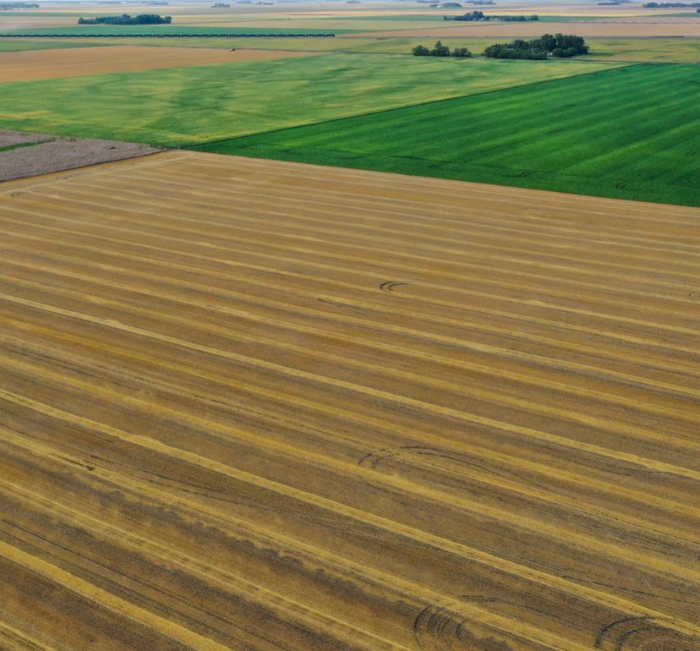Today, we’re looking at commodities.
In recent months, there has been a remarkable surge in the prices of cocoa and coffee — two beloved commodities that are staples in households, cafes and bakeries.
This took the market by surprise, and has left many puzzled. What are the driving forces behind the rapid price escalation? Are other commodities primed to pop? What’s the best way to invest in this stuff?
To find out, we got help from Lukas Kuemmerle, who writes an insightful and technical Substack called Commodity Report.
Let’s go 👇
Table of Contents
🌾 From the farm to your bank account
To feed the world’s growing population, farmers will need to produce as much food over the next 40 years as they produced in the last ten thousand.
We’ll need big investments in farms and agribusinesses. That’s why Harvest Returns offers exclusive private opportunities for investing in farming and ranching operations.

Invest in ranches, farms, and AgTech companies:
🚜 Ranches and Farms
- Invest in helping American farmers start + grow operations.
- You can invest in projects such as hydroponic farms, indoor aquaculture facilities, or vineyards for $5,000
- Includes ranchers practicing regenerative agriculture (a topic we’ll cover soon)
🌱 AgTech Companies
- Farmers are adapting high tech to improve their yields and profitability
- Precision drones + biotech is revolutionizing the way food is grown.
- Harvest Returns provides investors access to high-potential, early stage AgTech companies.
Lately we’ve been exploring Harvest’s newest offering: their Private Credit Fund.
🆕 Private Credit Fund
- Diversified assets across varied agriculture sectors+geos
- 1-3 year maturity debt notes (to leverage high interest rates)
- Quarterly cash distributions. First distribution is projected for June
- High targets: 14.5% IRR and a 1.5x exit multiple
What are the most popular commodities?
2023 was a tough year for most commodities, with slower global growth, weakened demand, and surpluses.
Before we get into cocoa, it’s important to understand the most actively traded commodity markets:
- 🛢️ Crude Oil: Critical to the global economy. Huge daily trading volume (through futures and contracts).
- 🥇 Gold: Love it or hate it, it’s perceived as a hedge against inflation and economic uncertainty.
- ⛏️ Metals: Important as a store of value and for industrial applications. Includes silver, copper* and rare earths.
- 🌾 Agriculture: Crops like wheat, corn, and soybeans are essential to global food production & trade. (Cocoa and coffee are included here.)
- 🐄 Livestock: Beef prices are flirting with record highs because American cattle herds are at historical lows. Ranchers need capital to rebuild them.
*A quick note on copper: Copper futures just hit a two-year high, and investors are starting to take notice. Metals are in their own universe, as they don’t rely on the same factors as agricultural commodities. My opinion is that during the next few weeks some people will make good money shorting this market.

How do people invest in commodities?
Commodities often have a low correlation with mainstream asset classes. It’s a hedge against market downturns, inflation and geopolitical risk (which you may have noticed is…especially high these days.)
While physically owning commodities gives direct exposure to price movements, it also has a bunch of problems around storage costs (commodities often have limited shelf lives) and logistical complexities. My company (Kucrop Analytics) doesn’t cover physical commodity exposure.
Investors commonly access commodities through futures. Futures trading allows you to hedge against volatility and speculate on future price movements.
Another option is through agriculture ETFs, which reflect futures prices:
- Teucrium Corn Fund (CORN): CORN is designed to track the price movements of corn by investing in corn futures contracts.
- Invesco DB Commodity Index Tracking Fund (DBC): DBC is designed to track the performance of a diversified basket of commodities, including energy, metals, and agriculture.
- iShares MSCI Global Agriculture Producers ETF (VEGI): VEGI gives exposure to companies involved in the agriculture industry, including livestock and agricultural machinery. (It’s like a less direct, public version of what you get with Harvest Returns.)
- Wisdom Tree Cocoa ETF (COCO): European investors have a unique opportunity with WisdomTree Cocoa, which tracks the Bloomberg Cocoa Sub Excess Return Index, and is available for trading on the London Stock Exchange and Borsa Italiana (Italian Stock Exchange in Milan).

You’d think the United States would be an exchange-traded product that provides pure exposure to Cocoa futures, right?
Incredibly, there are none!
The last product that did so was the iPath Bloomberg Cocoa Subindex Total Return ETN (NIB), but it was delisted in June 2023. (Great timing! Ugh…)
What caused cocoa to skyrocket? 🍫
Unlike financial assets, commodities are subject to fluctuations based on environmental conditions.
The meteoric rise in cocoa is due to a confluence of factors.
Weather
While cocoa is produced in tropical nations around the world, the vast majority of the world’s supply comes from West Africa (specifically the Ivory Coast).

The recent prevalence of El Niño has inflicted severe damage on cocoa plants, and growers are facing catastrophic harvests.
El Niño’s adverse effects range from prolonged droughts, to erratic rains and floods, to dry & dusty Harmattan winds.
This not only creates an immediate supply shortage; it jeopardizes the long-term sustainability of cocoa production in the region.
Make no mistake: This shortage could easily spell the beginning of the end of West Africa’s cocoa supremacy, and open the door for ascendant producers in Latin America and Papua New Guinea.
Disease
To make matters worse, a non-native plant virus has now infected half a million acres of cocoa farms.
590,000 hectares have been infected with swollen shoot, which spreads from plant to plant and ultimately kills it. (To put this in perspective, 590k hectares represents half of Ghana’s entire cocoa cultivation)
Cocoa is already driving deforestation. Lush tropical rainforests are usually cut down to make way for cocoa monoculture.
But swollen shoot is usually dealt with by cutting down the infected trees entirely, and that’s not easy to recover from.
Production is in long-term decline. We wouldn’t get the lowest crop for 20 years in Ghana and the lowest for eight years in Ivory Coast if we hadn’t reached a tipping point.
– Steve Wateridge, cocoa expert with Tropical Research Services.
Speculation
This fundamental weather event has led to a short squeeze situation in the cocoa futures market.
Enticed by the potential for quick gains, speculators have flocked to the market, injecting volatility and driving prices to unprecedented heights.
Their influence has become increasingly palpable, overshadowing traditional supply and demand dynamics.
As investors pour money into these markets, their actions often amplify price movements, creating a feedback loop that propels futures prices ever higher.
What about coffee? ☕
Looking at the coffee market, we see a different picture. In fact we think that there is a divergence brewing between fundamentals and technicals.

While coffee prices also surged higher during the past few weeks, we did not find a major fundamental price trigger for that move.
We believe that the coffee rally is a byproduct of the cocoa saga.
Speculators jumped into the long coffee trade after realizing they could make a quick buck betting on higher and higher cocoa prices.
We can see that clearly in the positioning data, where commercials are massively short and speculators are massively long.
However, it’s crucial to recognize that the commodity complex extends beyond soft commodities like cocoa and coffee…
Opportunities in grain land? 🌾
Are speculators too short?
At Kucrop Analytics, we try to spot trends & reversals before they happen, and deliver signals as well as bespoke research to institutional clients.
During the most recent months, grains (like soybeans, corn, and wheat) got sold off massively, as weather conditions in South and North America relaxed and drought conditions retreated.
The latest positioning data from the Commodities Futures Trading Commission (CFTC) shows that speculators have built up a record net short position in the grain complex.
When trading commodities futures contracts, you always need two parties: buyer and seller.
The main balance of power we look at is between speculators (usually hedge funds or large institutions) and commercials (often producers like Nestle or Mondelez).
We use speculative positioning as a classic contra indicator.
According to the latest CFTC data and our research we see a massive opportunity brewing, thanks to excessive short positioning by speculators.

As we progress through 2024, we believe conditions are ripe for a reversal in sentiment, signaling the emergence of a long grains trade.
At Kucrop Analytics, we have started to build on a larger long trade in the grains sector.
While the position is still small, we plan to add to the trade if we see that momentum gets into the soy and corn markets.
Sentiment analysis
Another example of our research can be commodity sentiment.
Great contra indicators are major cover stories by Barrons or The Economist. But once niche stories get the attention of a mass audience, something tends to be priced in. This strengthens the odds of a major trend reversal in a particular niche commodity market.
A great example was the surge in wheat prices after Russia invaded Ukraine in 2022.

We haven’t seen any sentiment impulse for grains yet, but you can bet we’re actively monitoring social sentiment.
Potential trigger event
According to the latest data, the current El Niño weather pattern (one of the main triggers for the recent cocoa rally) will likely retreat and turn into La Niña within the next few months.
The convergence of favorable weather conditions, coupled with the influence of La Niña, sets the stage for heightened volatility and opportunity in the grains market.
A quick note on grains:
- Corn and soybeans are usually referred to as feed grains, because their primary use is to feed animals 🫘
- Wheat and rice are referred to as food grains since they’re primarily directed towards human consumption 🍚
When it comes to feed grains, South America is now the world leader in corn and soybean exports. Big weather events — especially in Brazil and Argentina — can greatly influence global markets.
Specifically, La Niña typically impacts the South American summer, potentially causing greater harm to crops. This could explain why the recent two occurrences of La Niña have significantly boosted crop prices.

Meanwhile, La Niña’s impact on North America tends to come during the winter, well away from the critical growing and harvest seasons. So there are basically no implications for North American crops during summer.
As a result, during La Niña’s summers, growing conditions in the US are usually relatively ideal.
As speculators continue to adjust their positions and market dynamics evolve, the grains market stands at a pivotal juncture, poised for a potential trend shift caused by the coming La Niña, and excessive speculative short positioning.
Time to buy milk futures? 🥛
Recently, Wyatt had some interesting thoughts on the bull case for a very alternative commodity: milk.
And again, the reason why is disease.
Per Wyatt..
“Before today, I didn’t know milk futures were a thing. I guess there’s a futures market for most stuff (agaves excluded).
If the reporting I’m seeing is right, though, milk futures are about to become much more important.
For the first time, H5N1, or bird flu has jumped to US dairy cows and has infected more than 20 herds across the United States.

While Big Cow tries to keep the problem under wraps by mostly saying it’s not a problem at all, public health officials are getting worried.
So what’s the problem?
Well, bird flu can pass between cows and people, and bird flu is often fatal in humans.
So if a significant number of American cows get bird flu, they’ll have to be culled. Over 85 million chickens and turkeys have been culled over the last two years, and the same thing will happen to cows.
This means that beef, milk, cheese, yogurt, chocolate, and other dairy products will become very expensive.
Anyway, pay attention to the milk futures index.

It’s already ticking up.
Closing thoughts
There’s always a bull market out there. We believe the current situation will open up many opportunities in the grain sector on the long side.
But to make money in commodities, it’s important to understand that it’s highly cyclical. The price action and fundamental drivers aren’t comparable with equities or crypto.
Buy and hold strategies do not work in this environment.
Only well-timed ideas over a medium holding period do.
Disclosures
- This issue was sponsored by Harvest Returns
- This issue was co-authored by Lukas Kuemmerle, who is long grains.
- No other authors, nor the ALTS 1 Fund has any holdings in any companies mentioned in this issue
- This issue contains affiliate links to TradingView. If you sign up, we get a few bucks.













